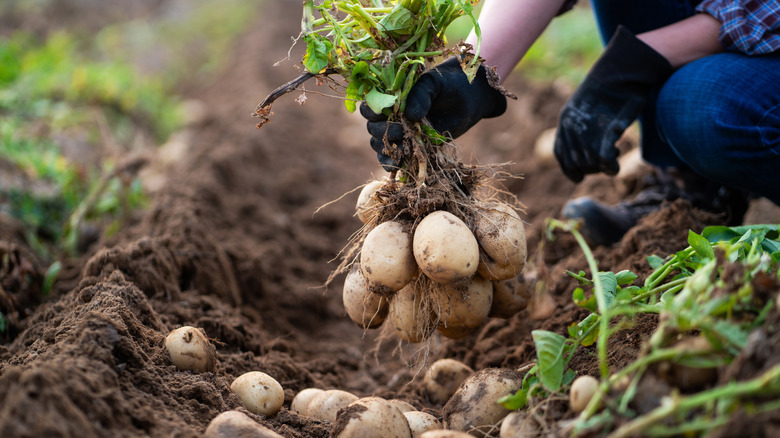What Are Those Things That Grow Out Of Potatoes?
Potatoes are a staple food enjoyed around the world. Not only are they highly nutritious, but they seem to be able to grow in almost any condition. With minimal light and no soil, potatoes will start to grow their famous "eyes" if left alone for long enough. You can even grow them in nothing more than a glass of water for a cool science experiment. But what are those growths exactly?
Unlike plants that can only propagate from seeds, potatoes can sprout new shoots straight from their tubers. It's an evolutionary adaptation that many tubers possess to help ensure the plant can propagate even when conditions aren't conducive to seed germination. Of course, because the plants that grow from the tubers aren't germinated, they're essentially clones of the original plant. While potatoes do have seeds and flowers for sexual reproduction, their tubers possess those iconic "eyes" as a means of ensuring growth.
The little dark-colored bumps on potatoes that some people refer to as "eyes" are dormant sprouts. Their dormancy is controlled by hormones in the tuber that stop the plant from growing if the right conditions aren't met. But they aren't picky. Any environment even remotely similar to conditions under the soil, where potatoes grow naturally, is enough for the hormones to reduce their concentrations and allow the sprouts to start growing. Ideally, potatoes will sprout in the warm, well-drained, sandy loam soil that's common to their origins in the Andes mountains. However, because potatoes already contain the nutrients and materials needed to grow, they can sprout in any well-ventilated, dry, and dark conditions, such as those found in a kitchen pantry — no soil needed.
Why you shouldn't eat the things that grow out of potatoes
The history of the potato is marked by stories of great famines, wars, agricultural revolutions, and cultural upheaval. Perhaps one of the most significant events in the potato's timeline was its introduction to Europe in the mid-16th century. After a bloody campaign of conquest in the Andes, New World crops and animals were brought back to Europe, some as curiosities, others for cultivation. The potato was treated as both.
Europeans often raised the plant in botanical gardens to showcase its fast-growing green leaves and beautiful flowers. There are no primary documents to verify an oft-repeated story of Queen Elizabeth serving potato greens at a party and poisoning her guests, however, if anyone had eaten the green parts, they would have become seriously ill. French authorities even banned potato cultivation for a time, citing its potential to cause disease, leprosy in particular. Yet, while potatoes aren't responsible for leprosy, their growths do contain toxins called glycoalkaloids.
Glycoalkaloids are chemical compounds found in numerous plant species. Bitter and toxic, glycoalkaloids serve as a natural defense against pests. Plants in the nightshade family, which include potatoes, peppers, eggplants, and tomatoes, contain a particularly poisonous glycoalkaloid called solanine. Some potato bugs have evolved to tolerate solanine, but humans can experience diarrhea, vomiting, dizziness, fevers, and other nasty effects from consuming it in large quantities. Growths on potatoes, even before the sprouts develop large shoots and leaves, contain such glycoalkaloids. However, you would need to eat a lot of them before you get sick. Some people are more sensitive to glycoalkaloids, and some are even allergic to trace amounts. Therefore, it's best to play it safe and cut off any of "those things that grow out of potatoes" before prepping your next potato salad.

